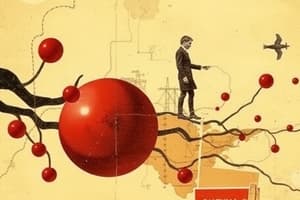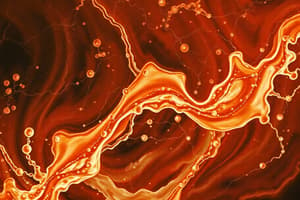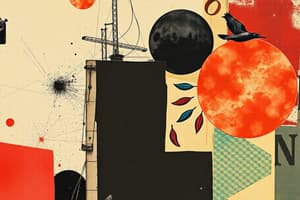Podcast
Questions and Answers
What is the primary function of hemoglobin in the body?
What is the primary function of hemoglobin in the body?
- To store nutrients
- To recycle iron
- To transport oxygen (correct)
- To transport carbon dioxide
How many heme groups are present in each hemoglobin molecule?
How many heme groups are present in each hemoglobin molecule?
- 2
- 4 (correct)
- 1
- 3
What happens to the iron in senescent red blood cells?
What happens to the iron in senescent red blood cells?
- It is excreted through urine
- It is used for energy production
- It is converted to bilirubin
- It is recycled or stored (correct)
What component of hemoglobin is responsible for binding oxygen?
What component of hemoglobin is responsible for binding oxygen?
Where are senescent red blood cells primarily broken down?
Where are senescent red blood cells primarily broken down?
What is the final breakdown product of hemoglobin that is primarily released into the liver?
What is the final breakdown product of hemoglobin that is primarily released into the liver?
What is the primary function of ferritin in the body?
What is the primary function of ferritin in the body?
Which color is associated with biliverdin, one of the breakdown products of hemoglobin?
Which color is associated with biliverdin, one of the breakdown products of hemoglobin?
What happens to iron after it is absorbed into the bloodstream from the intestinal cell?
What happens to iron after it is absorbed into the bloodstream from the intestinal cell?
What is the metabolite of bilirubin that contributes to the brown color of feces?
What is the metabolite of bilirubin that contributes to the brown color of feces?
Which form of iron is primarily absorbed in the intestine from dietary sources?
Which form of iron is primarily absorbed in the intestine from dietary sources?
Which organ is primarily responsible for storing iron in the form of ferritin?
Which organ is primarily responsible for storing iron in the form of ferritin?
What additional step is required to absorb ferric iron (Fe3+) into the intestinal cells?
What additional step is required to absorb ferric iron (Fe3+) into the intestinal cells?
What role does the hormone hepcidin play in iron metabolism?
What role does the hormone hepcidin play in iron metabolism?
During which life stages is the need for iron particularly high?
During which life stages is the need for iron particularly high?
What is one consequence of iron loss due to blood loss?
What is one consequence of iron loss due to blood loss?
What factor increases the iron requirements during certain life stages?
What factor increases the iron requirements during certain life stages?
Which of the following conditions can lead to iron deficiency despite adequate iron intake?
Which of the following conditions can lead to iron deficiency despite adequate iron intake?
What mechanism is involved in iron loss during intense exercise?
What mechanism is involved in iron loss during intense exercise?
Which of the following is a storage form of iron in the body?
Which of the following is a storage form of iron in the body?
Flashcards
Hemoglobin function
Hemoglobin function
Carries oxygen in the blood, each molecule has four heme groups with iron, binding up to 16 oxygen molecules.
Hemoglobin breakdown
Hemoglobin breakdown
Old red blood cells are broken down by macrophages, converting hemoglobin to heme, then into biliverdin (green) and bilirubin (yellow).
Iron forms
Iron forms
Found in two forms: Ferrous (Fe2+) in animal products and Ferric (Fe3+) in plants. Ferrous is absorbed more easily.
Iron absorption
Iron absorption
Signup and view all the flashcards
Iron transport
Iron transport
Signup and view all the flashcards
Iron storage
Iron storage
Signup and view all the flashcards
Hepcidin function
Hepcidin function
Signup and view all the flashcards
Iron deficiency anemia
Iron deficiency anemia
Signup and view all the flashcards
Hemolytic anemia
Hemolytic anemia
Signup and view all the flashcards
Anemia symptoms
Anemia symptoms
Signup and view all the flashcards
Anemia in cancer
Anemia in cancer
Signup and view all the flashcards
EPO function
EPO function
Signup and view all the flashcards
Blood Coagulation
Blood Coagulation
Signup and view all the flashcards
Fibrin function
Fibrin function
Signup and view all the flashcards
Anti-thrombotic mechanisms
Anti-thrombotic mechanisms
Signup and view all the flashcards
Coagulation Factor Importance
Coagulation Factor Importance
Signup and view all the flashcards
Deep Vein Thrombosis (DVT)
Deep Vein Thrombosis (DVT)
Signup and view all the flashcards
DVT risk factors
DVT risk factors
Signup and view all the flashcards
DVT complications
DVT complications
Signup and view all the flashcards
Anticoagulation therapy
Anticoagulation therapy
Signup and view all the flashcards
Study Notes
Hemoglobin
- Hemoglobin carries oxygen in our blood; it has 4 heme groups, each has an iron ion that binds to oxygen.
- Each hemoglobin molecule can bind up to 16 oxygen molecules.
- Red blood cells contain around 270 million hemoglobin molecules.
- Old red blood cells (senescent) are broken down by macrophages, primarily in the spleen and liver.
- When red blood cells are broken down, hemoglobin is converted into heme.
- Heme is then broken down into biliverdin (green) and bilirubin (yellow).
- Bilirubin is the final product of hemoglobin breakdown and is excreted in the feces and urine.
Iron Metabolism
- Iron is essential for the formation of the heme group in hemoglobin. We consume iron in two forms:
- Ferrous iron (Fe2+): Also known as heme iron, it is found in red meat and animal products.
- Ferric iron (Fe3+): Found in plants and cast iron cookware.
- Ferrous iron is more easily absorbed in the intestines; it is transported into enterocytes (intestinal cells).
- Ferric iron needs to be converted into ferrous iron before it can be absorbed.
- Once in the enterocytes, iron can be bound to ferritin (a storage form of iron) or transported into the bloodstream.
- When iron enters the bloodstream, it is converted back to ferric iron and binds to transferrin, the main protein for iron transport in the blood.
- Transferrin carries iron to various tissues, including bone marrow, muscles, and the liver.
- In bone marrow, iron is used to make hemoglobin.
- In muscles, iron is used to make myoglobin.
- The liver stores iron in ferritin, a storage form.
- Hepcidin, a hormone, regulates iron levels and storage in the body.
- Iron deficiency can result from:
- Low iron intake
- Excessive iron loss (e.g., blood loss, hemolysis)
- Malabsorption of iron (e.g., celiac disease, parasitic infections)
Iron Deficiency
- Iron deficiency can lead to anemia, a condition where there is not enough red blood cells or hemoglobin to carry oxygen.
- During pregnancy, lactation, infancy, and adolescence, iron requirements are higher due to growth and high energy demands.
- Endurance exercise increases red blood cell production and thus increases iron needs.
- Blood loss (e.g., trauma, surgery, menstruation) leads to iron loss and can contribute to iron deficiency.
- Intravascular hemolysis (breakdown of red blood cells within the blood vessels) can also cause iron loss.
- Malabsorptive conditions can prevent iron from being absorbed into the body, regardless of iron intake.
Hemolytic Anemia
- Hemolytic anemia is a condition where red blood cells are destroyed prematurely.
- This can be caused by a variety of factors, including genetic defects, infections, and autoimmune disorders.
- One less commonly discussed cause is dilutional anemia, which occurs due to increased plasma volume, often seen during pregnancy where fluid retention dilutes the blood cells.
Clinical Signs and Symptoms of Anemia
- Anemia reduces oxygen carrying capacity, leading to a need for increased resting cardiac output.
- This manifests as a faster heart rate and increased contractility, putting extra strain on the heart.
- Over time, untreated anemia can lead to long-term cardiac damage.
- It also causes exercise intolerance, shortness of breath, and overall fatigue.
Anemia in Cancer Patients
- Anemia is common in cancer patients due to side effects of chemotherapy and radiation therapy, which disrupt bone marrow function.
- Cancer itself also triggers a pro-inflammatory cascade contributing to anemia.
Erythropoietin (EPO)
- EPO is a hormone responsible for stimulating red blood cell production.
- It is used as a medication to treat anemia in patients with cancer and other chronic diseases.
- EPO is unfortunately abused by endurance athletes because it can boost red blood cell count, increasing oxygen carrying capacity and enhancing performance.
- However, artificially boosting EPO can lead to dangerously high red blood cell counts, making blood thicker and increasing the risk of clotting and cardiovascular problems.
Blood Coagulation
- This is the process of forming a blood clot to stop bleeding, involving a cascade of events.
- The cascade begins with injury to the endothelium, exposing underlying collagen.
- This triggers the release of endothelin, a vasoconstrictor, which narrows the blood vessel and slows blood flow.
- Platelets adhere to the exposed collagen and release cytokines that attract more platelets, forming a platelet plug (primary hemostasis).
The Role of Fibrin
- The platelet plug is strengthened by fibrin, which acts as a glue to hold platelets together (secondary hemostasis).
- Fibrin is formed by the conversion of fibrinogen, a plasma protein, into fibrin.
- This conversion is initiated by tissue factor, which is released upon tissue injury.
- A complex cascade of coagulation factors, including prothrombin and thrombin, ultimately leads to fibrin formation.
- Thrombin is the main enzyme responsible for activating fibrinogen.
Anti-thrombotic Events
- The clotting process is regulated by anti-thrombotic mechanisms that prevent excessive clot formation.
- These mechanisms include tissue plasminogen activator and thrombomodulin, which dissolve fibrin and ultimately break down the clot.
Importance of Coagulation Factors
- The coagulation cascade involves many different proteins (coagulation factors), each playing a specific role.
- Deficiencies in these factors can lead to impaired clotting and excessive bleeding.
- For example, a deficiency in factor VII, IX, or X, which are vitamin K dependent, can disrupt the entire cascade, hindering clot formation.
- This can occur due to genetic defects (e.g., hemophilia) or nutritional deficiencies (e.g., vitamin K deficiency).
Deep Vein Thrombosis (DVT)
- DVT is a serious medical condition where a blood clot forms in a deep vein, causing damage to nearby tissue.
- DVT often occurs in the legs but can also occur in the arms.
- DVT can be fatal if untreated.
Signs and Symptoms of DVT
- Swelling and redness in the area distal to the clot.
- Decreased venous return due to obstruction.
- Increased capillary pressure leading to fluid filtration and edema in the affected area.
- Redness of the skin due to blood pooling in the capillaries.
Risk Factors for DVT
- Stasis or blood that is not moving as rapidly as it normally would.
- This is why DVT is associated with long flights on airplanes: prolonged sitting with legs in a down position can cause blood to pool in the veins.
- Prolonged bedrest can also increase the risk of DVT.
- Atrial fibrillation can lead to blood pooling in heart atria and increase clotting risk.
DVT Treatment
- DVT is a medical emergency that requires immediate attention.
- Patients with suspected DVT should be immediately referred to the emergency room.
- DVT can migrate to other parts of the body, including the lungs (pulmonary embolism), brain (stroke), or coronary arteries (myocardial infarction).
- Mobilizing a DVT can worsen its condition and lead to potentially fatal consequences.
Management of DVT
- Physical therapists should be aware of the potential risks of DVT and understand its seriousness.
- It is crucial to recognize the signs and symptoms of DVT to ensure appropriate medical intervention.
- Avoid mobilizing patients with suspected DVT as this can dislodge the clot and lead to further complications.
Deep Vein Thrombosis (DVT)
- Sitting still for long periods with legs down increases risk of DVT
- Dehydration also increases risk of DVT:
- Air in airplanes is dry, causing dehydration
- Dehydration concentrates blood, making platelets more concentrated.
- Pro-inflammatory environments also increase risk of DVT
- Cancer is a pro-inflammatory environment
- Certain stages of pregnancy are pro-coagulatory
- Medications can also increase risk of DVT
- Athletes are at increased risk of DVT:
- Large veins after endurance training and bodybuilding can accumulate blood
- Muscle damage after exercise causes inflammation
- DVT is easy to check for visually
Anticoagulation Therapy
- Anticoagulation therapy can be life-saving for patients needing to reduce clotting
- It comes with risks of side effects:
- Excessive bruising
- Difficulty stopping bleeding
- Anticoagulation therapy increases risk of bleeding with:
- Cupping therapy due to increased blood flow
- Dry needling due to disruption of blood supply
- Trauma like falls or motor vehicle accidents
Coagulation Issues
- Thrombus: Clot in blood vessel that reduces blood flow
- Embolism: Blockage of blood vessel, not necessarily a clot
- Examples: Air embolism, thromboembolism
- Thromboembolism: Clot that travels elsewhere in the body
- Petechiae: Less than 1mm red dots on the skin
- Result of leaks from capillaries due to insufficient coagulation
- Purpura: Larger red masses on the skin
- Same cause as petechiae
- Ecchymosis: Large red spots on the skin
- Indication of insufficient coagulation
- Causes of insufficient coagulation:
- Not enough clotting factors (fibrinogen, fibrin)
- Too much anti-clotting (plasminogen)
- Increased risk of insufficient coagulation in:
- Patients on anticoagulant medication
- Patients with high dosage of anticoagulant medication
- Patients with cognitive dysfunction, especially geriatric patients
Studying That Suits You
Use AI to generate personalized quizzes and flashcards to suit your learning preferences.
Description
Test your knowledge on the functions and metabolism of hemoglobin and iron in the body. This quiz includes questions about heme groups, the breakdown of red blood cells, and the role of ferritin and bilirubin. Perfect for students studying biology or human physiology.




